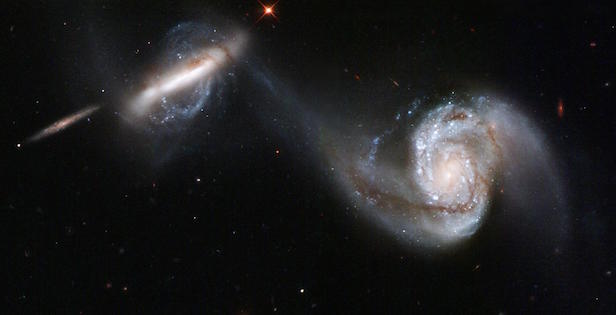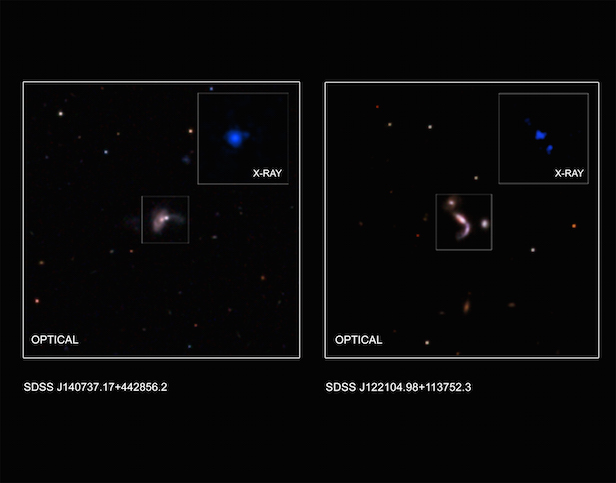Astronomers discover multiple supermassive black hole pairings
Fewer than ten of these double gigantic high-gravity objects were known previously

Black hole pairings are the result of two galaxies colliding and merging due to their gravitational attraction. Image credit: NASA/ESA/Hubble Heritage Team (STScl/AURA)
Astronomers have uncovered an unexpectedly high number of supermassive black hole partners at the centres of their host galaxies. By identifying five pairs of these high-gravity objects, the astronomers are hoping this research will explain how galaxies merge and their black holes produce gravitational waves.
Each pair of supermassive black holes contains millions of times the mass of our Sun, and the leading theory for their formation is that they are the result of two galaxies colliding and eventually merging. “Astronomers find single supermassive black holes all over the universe,” says Shobita Satyapal, from George Mason University in Fairfax, Virginia. “But even though we’ve predicted they grow rapidly when they are interacting, growing dual supermassive black holes have been difficult to find.”
Prior to this study, there were less than ten confirmed pairs of growing black holes by X-ray studies, and these only occurred because of unplanned detections. The numbers have been improved thanks to the combined data of NASA’s Chandra X-ray Observatory, the Wide-Field Infrared Sky Explorer Survey (WISE) and the Large Binocular Telescope in Arizona.
This work originated from the Galaxy Zoo project – a crowd sourced astronomy project – where the researchers sifted through much of the Sloan Digital Sky Survey’s (SDSS) optical data. To start with, the researchers had to single out the galaxies where it appeared two smaller galaxies were currently merging. They then had to differentiate the ones where the two centres of the galaxies were 30,000 light years apart, and this was confirmed by the WISE infrared data.

These galaxies were observed in different wavelngths, from infrared to X-ray. Image credit: X-ray: NASA/CXC/Univ. of Victoria/S.Ellison et al. & NASA/CXC/George Mason Univ./S.Satyapal et al. Optical: SDSS
From this analysis, seven candidates appeared and each of them contained at least one supermassive black hole. Satypal and her team then observed each of these targets using Chandra, as strong X-ray emission is an indication of growing supermassive black holes. This confirmed five closely separated pairs of X-ray sources, thus providing strong evidence for the presence of two growing black holes.
“Our work shows that combining the infrared selection with X-ray follow-up is a very effective way to find these black hole pairs,” says Sara Ellison of the University of Victoria in Canada. “X-rays and infrared radiation are able to penetrate the obscuring clouds of gas and dust surrounding these black hole pairs, and Chandra’s sharp vision is needed to separate them.”
Studying merging black holes is currently an extremely popular subject, with the recent discoveries of gravitational waves and the discoverers’ Nobel Prize win. This work is a step in the right direction to understanding where gravitational waves originate. “It is important to understand how common supermassive black hole pairs are, to help in predicting the signals for gravitational wave observatories,” said Satyapal. “With experiments already in place and future ones coming online, this is an exciting time to be researching merging black holes. We are in the early stages of a new era in exploring the universe.”
Keep up to date with the latest reviews in All About Space – available every month for just £4.99. Alternatively you can subscribe here for a fraction of the price!




